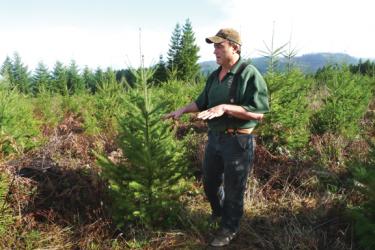Natives and Transplants
No matter where your woods are, the conditions there—how frequent droughts or floods are, for example—have shaped them.
Native plants have adapted to these local conditions, so native trees are usually the best choice for keeping your woodland healthy. They also tend to provide higher-quality habitat for native wildlife and require less water and maintenance, which benefits you too.
Not all nonnative or transplant species are harmful. Apples, for example, aren’t native, and they’re beneficial to our diets and our woodlands. But when a nonnative species overruns an area and chokes out native species, it can cause ecological imbalance and leave landowners with an expensive problem. When that happens, the nonnative is called an invasive species. Learn more about invasive species.
How do you know if you have natives or transplants in your woods? The leaves, bark, seed pods or flowers on your trees can clue you in. Take a look at them during your forest health assessment, and jot down what you see. Do they all look the same? How do they differ?
To get specific about the species in your woods, use a tree identification guide and compare it to what you’ve observed. If you see:
| One tree species present | May mean your forest is not as healthy as it could be. Consider planting a few trees of a species not yet growing in your woods. |
| Two tree species present | Usually indicates fair health. A bit more diversity would probably benefit your woods, but you're doing well. |
| Three or more tree species present | Indicates good forest health. |
Of course, your trees are only part of all the layers of plant life in your woods. Every layer contributes to the health of your forest. They usually fall into these categories:
- Overstory = all the trees whose canopies are fully exposed to the sun.
- Understory = the trees that are growing in the shade of other trees.
- Tall shrub = shrubs greater than 6 feet in height. Shrubs are woody plants with several stems rising from the base.
- Short shrub = shrubs less than 6 feet in height.
- Forb = herbaceous (non-woody) plants, such as ferns, wildflowers and grasses.
- Leaf litter = dead and decaying leaves and other materials on the forest floor.
The more of these layers are present in your woods, and the more native plants you see in each category, the better your forest’s health will be.
The age of your forest is another important piece of the puzzle—and that’s one more area where diversity is good news.
A forester can help you understand your woods and what you activities you can do, specific to where you live, to create and maintain healthy woodlands.
Find out More
For help assessing and supporting the health of your woods, consult with
What trees are native in your area?
Top Ten Native Plants in Each Region: Provided by the National Wildlife Federation
*contains information adapted from the Project Learning Tree Secondary Grades 9-12 Module Focus on Forests
How can I get more tips?
It’s simple! Enter your email below.

